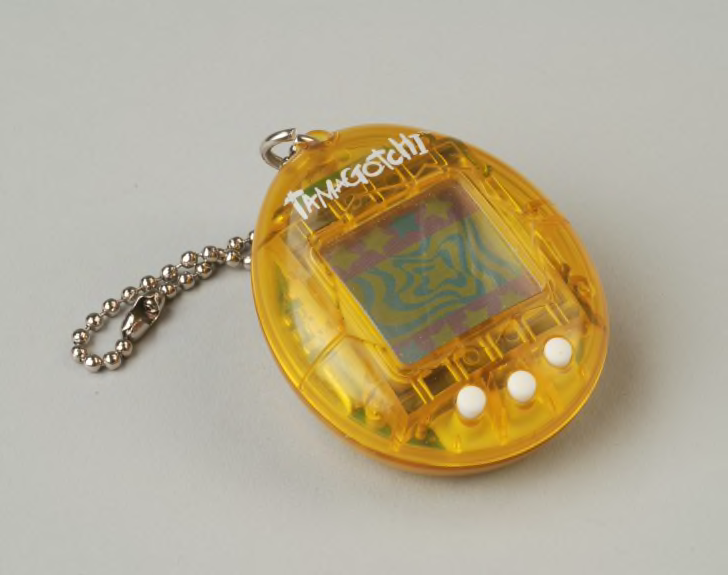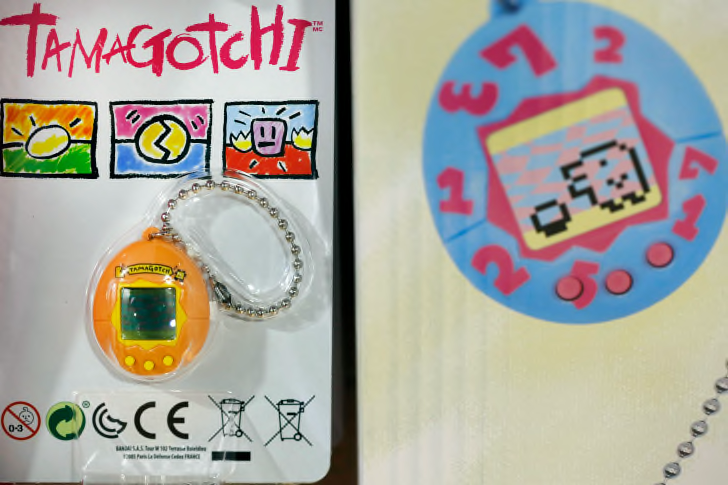11 Fascinating Facts About Tamagotchi
They blooped and beeped and ate, played, and pooped, and, for ‘90s kids, the egg-shaped Tamagotchi toys were magic. They taught the responsibility of tending to a “pet,” even though their shrill sounds were annoying to parents and teachers and school administrators. Nearly-real funerals were held for expired Tamagotchi, and they’ve even been immortalized in a museum (of sorts). Here are 11 things you should know about the keychain toy that was once stashed in every kid’s backpack.
1. The idea for the Tamagotchi came from a female office worker at Bandai.
Aki Maita was a 30-year-old “office lady” at the Japanese toy company Bandai when inspiration struck. She wanted to create a pet for kids—one that wouldn't bark or meow, make a mess in the house, or lead to large vet bills, according to Culture Trip. Maita took her idea to Akihiro Yokoi, a toy designer at another company, and the duo came up with a name and backstory for their toy: Tamagotchis were aliens, and their egg served as protection from the Earth’s atmosphere. They gave prototype Tamagotchis to high school girls in Shibuya, and tweaked and honed the design of the toy based on their feedback.
2. The name Tamagotchi is a blend of two Japanese words.
The name Tamagotchi is a mashup between the Japanese words tamago and tomodachi, or egg and friend, according to Culture Trip. (Other sources have the name meaning "cute little egg" or "loveable egg.")
3. Tamagotchis were released in Japan in 1996.

Museum Rotterdam, Wikimedia Commons//CC BY-SA 3.0
Bandai released the Tamagotchi in Japan in November 1996. The tiny plastic keychain egg was equipped with a monochrome LCD screen that contained a “digital pet,” which hatched from an egg and grew quickly from there—one day for a Tamagotchi was equivalent to one year for a human. Their owners used three buttons to feed, discipline, play with, give medicine to, and clean up after their digital pet. It would make its demands known at all hours of the day through bloops and bleeps, and owners would have to feed it or bathe it or entertain it.
Owners that successfully raised their Tamagotchi to adulthood would get one of seven characters, depending on how they'd raised it; owners that were less attentive faced a sadder scenario. “Leave one unattended for a few hours and you'll return to find that it has pooped on the floor or, worse, died,” Wired wrote. The digital pets would eventually die of old age at around the 28-day mark, and owners could start fresh with a new Tamagotchi.
4. Tamagotchis were an immediate hit.
The toys were a huge success—4 million units were reportedly sold in Japan during their first four months on shelves. By 1997, Tamagotchis had made their way to the United States. They sold for $17.99, or around $29 in today's dollars. One (adult) reviewer noted that while he was "drawn in by [the Tamagotchi's] cleverness," after several days with the toy, "the thrill faded quickly. I'm betting the Tamagotchi will be the Pet Rock of the 1990s—overwhelmingly popular for a few months, and then abandoned in the fickle rush to some even cuter toy."
The toy was, in fact, overwhelmingly popular: By June 1997, 10 million of the toys had been shipped around the world. And according to a 2017 NME article, a whopping 82 million Tamagotchi had been sold since their release into the market in 1997.
5. Aki Maita and Akihiro Yokoi won an award for inventing the Tamagotchi.
In 1997, the duo won an Ig Nobel Prize in economics, a satiric prize that’s nonetheless presented by Nobel laureates at Harvard, for "diverting millions of person-hours of work into the husbandry of virtual pets" by creating the Tamagotchi.
6. Tamagotchis weren't popular with teachers.
Some who grew up with Tamagotchi remember sneaking the toys into school in their book bags. The toys were eventually banned in some schools because they were too distracting and, in some cases, upsetting for students. In a 1997 Baltimore Sun article titled “The Tamagotchi Generation,” Andrew Ratner wrote that the principal at his son’s elementary school sent out a memo forbidding the toys “because some pupils got so despondent after their Tamagotchis died that they needed consoling, even care from the school nurse.”
7. One pet cemetery served as a burial ground for expired Tamagotchi.
Terry Squires set aside a small portion of his pet cemetery in southern England for dead Tamagotchi. He told CNN in 1998 that he had performed burials for Tamagotchi owners from Germany, Switzerland, France, the United States, and Canada, all of whom ostensibly shipped their dead by postal mail. CNN noted that "After the Tamagotchis are placed in their coffins, they are buried as mourners look on, their final resting places topped with flowers."
8. There were many copycat Tamagotchi.
The success of the Tamagotchi resulted in both spin-offs and copycat toys, leading PC Mag to dub the late ’90s “The Golden Age of Virtual Pets.” There was the Digimon, a Tamagotchi spin-off by Bandai that featured monsters and was marketed to boys. (There were also Tamagotchi video games.) And in 1997, Tiger Electronics launched Giga Pets, which featured real animals (and, later, dinosaurs and fictional pets from TV shows). According to PC Mag, Giga Pets were very popular in the United States but “never held the same mystique as the original Tamagotchi units.” Toymaker Playmates's Nano Pets were also a huge success, though PC Mag noted they were “some of the least satisfying to take care of."
9. Rare Tamagotchis can be worth a lot of money.
According to Business Insider, most vintage Tamagotchis won't fetch big bucks on the secondary market. (On eBay, most are priced at around $50.) The exception are rare editions like “Yasashii Blue” and “Tamagotchi Ocean,” which go for $300 to $450 on eBay. As Complex notes, "There were over 40 versions (lines) of Tamagotchi released, and each line featured a variety of colors and variations ... yours would have to be one of the rarest models to be worth the effort of resale."
10. A new generation of Tamagotchis were released in 2017 for the toy's 20th anniversary.

Chesnot/Getty Images
In November 2017, Bandai released a 20th anniversary Tamagotchi that, according to a press release [PDF], was "a first-of-its-kind-anywhere exact replica of the original Tamagotchi handheld digital pet launched ... in 1996." However, as The Verge reported, the toys weren't an exact replica: "They're about half the size, the LCD display is square rather than rectangle, and those helpful icons on the top and bottom of the screen seem to be gone now." In 2019, new Tamagotchis were released; they were larger than the originals, featured full-color displays, and retailed for $60.
11. The original Tamagotchi’s sound has been immortalized in a virtual museum.
The Museum of Endangered Sounds is a website that seeks to immortalize the digital sounds that become extinct as we hurtle through the evolution of technology. “The crackle of a dial-up modem. The metallic clack of a 3.5-inch floppy slotting into a Macintosh disk drive. The squeal of the newborn Tamagotchi. They are vintage sounds that no oldies station is ever going to touch,” The Washington Post wrote in a 2012 profile of the museum. So, yes, the sound of that little Tamagotchi is forever preserved, should it someday, very sadly, cease to exist completely.